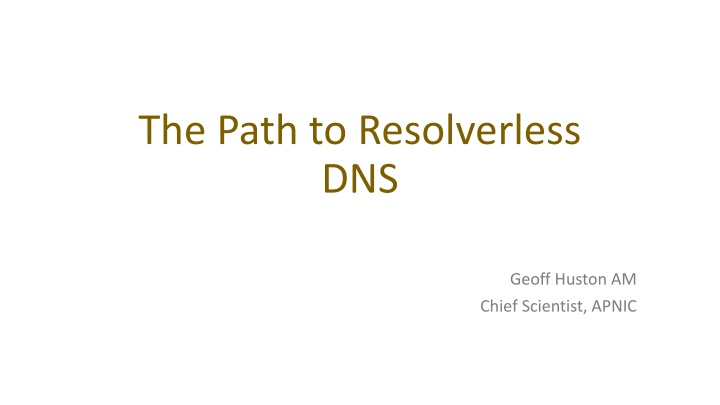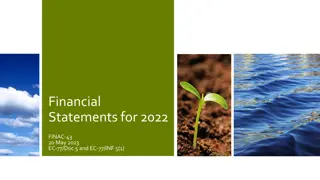
Resolverless DNS and Its Impact on Internet Architecture
Exploring the concept of resolverless DNS through the insights provided by Geoff Huston, Chief Scientist at APNIC. The article delves into DNS system architecture, issues affecting DNS speed and filtering, as well as the use of resolvers in the internet. It also discusses background information on browser vendors' responses and the use of unencrypted UDP for DNS queries.
Download Presentation

Please find below an Image/Link to download the presentation.
The content on the website is provided AS IS for your information and personal use only. It may not be sold, licensed, or shared on other websites without obtaining consent from the author. If you encounter any issues during the download, it is possible that the publisher has removed the file from their server.
You are allowed to download the files provided on this website for personal or commercial use, subject to the condition that they are used lawfully. All files are the property of their respective owners.
The content on the website is provided AS IS for your information and personal use only. It may not be sold, licensed, or shared on other websites without obtaining consent from the author.
E N D
Presentation Transcript
The Path to Resolverless DNS Geoff Huston AM Chief Scientist, APNIC
DNS System Architecture Authoritative Servers Recursive Resolver Cache Stub Resolver Application
DNS System Architecture Authoritative Servers Internet ISP Recursive Resolver Cache Client Stub Resolver Application
Issues DNS Speed the DNS can be exceptionally slow, and the interaction with resolver caches makes resolution unpredictable DNS Filtering the DNS is a convenient control point for content management DNS MetaData collection the DNS is a real time window on user behaviour This can be performed at the recursive resolver, or by a third party on the path between the stub resolver and the recursive resolver DNS as Search NXDOMAIN rewriting
Background Browser vendors were simplifying the UI and combined the navigation and search input boxes to a single window This resulted in a significant level of cross leakage between DNS and search Some DNS resolver operators saw an opportunity to gather revenue by re- directing NXDOMAIN to search Google responded quickly with a large scale open DNS service that provided absolute integrity of responses, and supported DNSSEC validation to back this up Google s DNS service rapidly gathered momentum, particularly in the enterprise sector
DNS System Architecture Authoritative Servers Internet Open Recursive Resolver Internet Cache !! ISP Client Stub Resolver Application
Use of Resolvers in the Internet 68% of users direct their DNS queries to the ISP-operated recursive resolvers 25% of users direct their DNS queries to Google s public DNS service 20% of users direct their DNS queries in in-country DNS https://stats.labs.apnic.net/rvrs
But DNS queries use unencrypted UDP Which itself is a huge DOS issue Combining this with a transit across the public Internet between the stub and open recursive resolver exposes further issues: The potential for third party monitoring, interception and substitution Loss of locational accuracy if the DNS is used to perform content steering for CDNs
DNS Privacy The response to the issues of DNS over UDP has been the development of DNS stub-to-recursive connections over encrypted transport sessions DNS over TLS (DoT) uses DNS over TCP over a persistent TLS session DNS over QUIC (DoQ) uses DNS over an encrypted QUIC transport session over UDP DNS over HTTPS (DoH) uses DNS over HTTP/3 (over QUIC) where supported, and DNS over HTTP/2 (over TLS) otherwise
DoT/DoQ/DoH properties The stub resolver can authenticate the recursive resolver server identity Which mitigates various forms of session interception Session encryption Which mitigates various forms of payload tampering No Head of Line Blocking (in DNS over HTTPS/3, and DoQ) No UDP fragmentation and TCP failover issues Long-held stub/recursive sessions and TCPFO can amortise the encryption and session overheads over many queries Which means it s not much different to UDP in terms of per query overheads
Why DoH in particular? DoH is simply DNS queries and responses packaged with an HTTP header, so why bother? Why not just use DoT or DoQ? One view: Paul Vixie, DNS Wars: Episode IV, NANOG 85, 2019
Why DoH? DoH is simply DNS queries and responses packaged with an HTTP header, so why bother? Why not just use DoT or DoQ? But maybe its more than a political project: Because it sits alongside all other HTTPS traffic on TCP port 443 (HTTP/2) and UDP port 443 (HTTP/3) and is harder for network level isolation of DNS traffic Because generic HTTP caching controls can be used to enable or disable the use of HTTP caching Because HTTP/2 and HTTP/3 includes support for reordering, parallelism, priority and header compression Because applications need not use the local stub DNS resolver and can direct DoH queries to a recursive resolver of its own choice Because HTTP/2 and HTTP/3 includes Server Push
Server Push? RFC 7540: Hypertext Transfer Protocol Version 2 (HTTP/2) 8.2. Server Push HTTP/2 allows a server to pre-emptively send (or "push") responses (along with corresponding "promised" requests) to a client in association with a previous client-initiated request. This can be useful when the server knows the client will need to have those responses available in order to fully process the response to the original request.
But in DoH this means 8.2. Server Push DNS DNS HTTP/2 allows a server to pre-emptively send (or "push") responses (along with corresponding "promised" requests) to a client in association with a previous client-initiated request. This can be useful when the server knows the client will need to have those responses available in order to fully process the response to the original request. DNS
What about HTTP/3? Yes draft-ietf-quic-http 4.4. Server Push Server push is an interaction mode that permits a server to push a request-response exchange to a client in anticipation of the client making the indicated request. This trades off network usage against a potential latency gain. HTTP/3 server push is similar to what is described in Section 8.2 of [HTTP2], but uses different mechanisms. Each server push is assigned a unique Push ID by the server. The Push ID is used to refer to the push in various contexts throughout the lifetime of the HTTP/3 connection.
So this means When a server sends a response to an HTTP request it can also push unrequested DNS responses This allows the user application to use these DNS resolution outcomes immediately and bypass DNS resolution delays It s faster The user is not making these resolution queries, and is not generating meta data within the DNS It has some privacy benefits
But How do you know that the server is pushing the truth when it provides these DNS answers? The secure transport means that tampering is challenging, but the user should still validate these responses (assuming that they are DNSSEC- signed in the DNS) Which would mean that the user still has to chase down the DNSSEC validation chain, and most of the the original speedup advantages are lost Or maybe not The server could also push the collection of DNSSEC validation responses to the client The server could also repackage these responses into a RFC7901 EDNS0 Chain Response, attached to the original response
DNSSEC-Validated DNS data DNSSEC validation provides the user with assurance that the data is: Authentic Current Complete (for each RRType) If that s the case then why does it matter how the stub learned the data? It could be a DNS query / response transaction It could be via a server push over DoH DNSSEC validation is providing the assurance that the data is usable
What if the DNS response is unsigned? Er, um, er It s probably best to discard it! You have no idea how the server obtained the DNS data in the first place You don t know how current the data is You really don t know if the server is trying to deceive you And you have no idea who you are implicitly trusting if you use the data
What can we say about Resolverless DNS? It gives HTTP-based applications and services far more control over the quality of the user experience It allows the server to pre-provision the client with DNS data that is likely to be useful in the context of the application It allows the client side application to perform rapid DNSSEC validation without relying on stub resolver capabilities and settings It can replace UDP-based timers, query retries, fragmentation and TCP switching with server-to-client provision It operates over a secured connection with an authenticated server As long as the DNS data is DNSSEC-signed
What about unsigned DNS data? Forget it! Resolverless DNS responses of unsigned DNS data just opens up more potential vulnerabilities with little in the way of reasonable mitigation
Where is this leading? The changing economics of the Internet The shift to advertiser-funded content and service has sucked the revenue base from access and common infrastructure Internet infrastructure is a commodity-based activity which resists innovation The incentives to innovate lie in the application and service layers Infrastructure is under continued pressure to achieve further efficiencies and there is a consequent pressure to scale up and centralise The DNS is caught up in this, and innovation in the DNS is extremely challenging to get adoption these days Does Resolverless DNS have a chance?
Is there a role for Resolverless DNS? Perhaps But I would suggest it necessarily assumes DNSSEC Which, at present, is a tough assumption Because few zones are signed Because DNSSEC signatures tend to create larger responses, which is a problem in UDP DNS Because advanced zone signing a zone is infeasible for very large zones And signing on the fly can be fragile In summary, few zones are DNSSEC are signed is because its unreliable and expensive and the benefits do not seem to offset against the additional risks And few resolvers validate Because it takes time And stresses out UDP DNS
What if we could dream? So far we ve thought of the DNS as a constant It s the same answer whether its delivered over UDP, DoT, DoQ or DoH But what if we could think about a DNS whose properties change depending on the mode of delivery of responses? What if we could work with a zone appears to be DNSSEC-signed when we use resolverless DoH, but the same zone appears to be unsigned in DNS over UDP? i.e. there is a DNSSEC validation path that exists only when it s chained to a response, but it s not visible when specifically queried as a sequence of DNS transactions? Or is this a completely fanciful notion?
Why is all this interesting? We have spent a huge amount of effort over the last decade trying to make the Internet faster: We ve been deploying CDNs to replicate content and services and bring them closer to users We ve been deploying non-blocking transport protocols (such as QUIC) to exploit parallelism We ve been tuning TCP and network behaviour to create more efficient and faster network transactions We ve been packing more information in the DNS to make service startup faster (SVC and HTTPS records)
Why is all this interesting? Yet the DNS is still: A massive time penalty A significant privacy leak A consistent source of failure Resolverless DNS won t fix all the DNS all at once But it can hand a significant amount of control over application and service quality back to these HTTPS-based applications and services And it s a whole lot faster! And for those reasons it s a very interesting step in the possible evolution of the DNS














